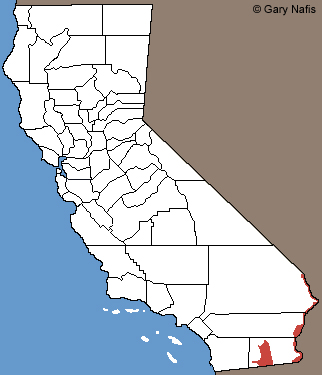 Red:
Red: Historical Range in California
(Now apparently not found anywhere in California)
Click on the map for a topographical view
Map with California County Names
Listen to this toad:

One short call
|
Formerly present, possibly extirpated in California.
All toads shown here were found outside of California.
|
 |
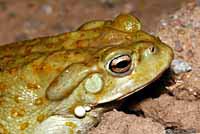 |
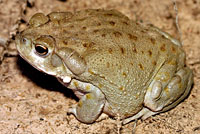 |
| Adult, Yuma County, Arizona |
Adult, Pima County, Arizona |
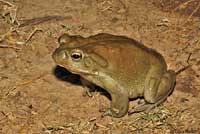 |
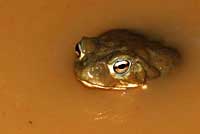 |
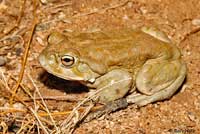 |
| Adult, Pima County, Arizona |
Adult, in breeding pool,
Pima County, Arizona |
Adult, Pima County, Arizona |
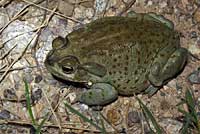 |
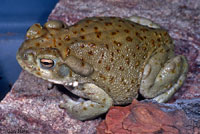 |
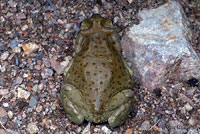 |
| Adult, Pima County, Arizona |
Adult, Pima County, Arizona |
Adult, Pima County, Arizona |
 |
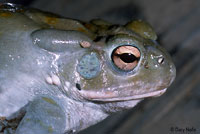 |
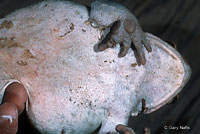 |
| Adult, Maricopa County, Arizona |
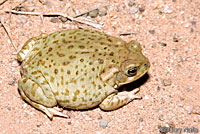 |
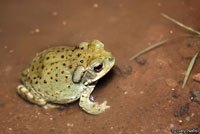 |
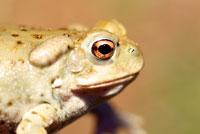 |
| Juvenile, Pima County, Arizona |
Juvenile, Pima County, Arizona |
 |
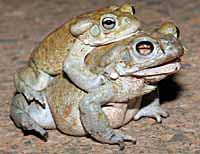 |
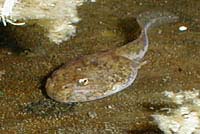 |
| Adult, Graham County, Arizona. |
Adults in amplexus, Pima County, Arizona © 2005 Jason Penny
|
Tadpole, Graham County, Arizona
© Albert Most |
| |
|
|
| Former California Habitat / Current Habitat in Arizona |
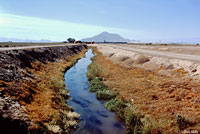 |
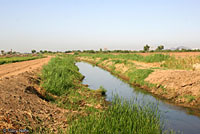 |
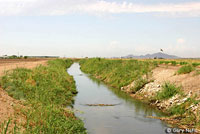 |
| Former habitat - Imperial valley agricultural drain, Imperial County |
Sonoran Desert Toads were once recorded from this area between Winterhaven and the Laguna Dam in Imperial County which is now all farmland. |
The toad from Yuma County, Arizona, shown above on the top left, was found one night in August on a road between two plowed agricultural fields next to this agricultural drain northeast of Yuma Arizona, about 20 miles east of California. The Sonoran Desert Toad utilized similar developed habitat in California along with undisturbed desert habitat before its disappearance in the state (see the Imperial County photos to the left.) This begs the question, why does this toad still persist in similar agricultural habitat nearby in Arizona and not in California?
|
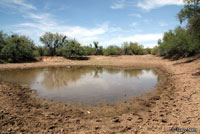 |
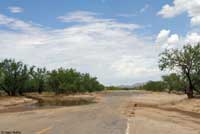 |
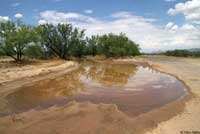 |
Breeding habitat, temporary rain pool, Maricopa County, Arizona
|
Breeding pool in a flooded wash, Pima County, Arizona. The night before this picture was taken, Sonoran Desert toads sat in the water and on the ground nearby. |
| |
|
| Short Video |
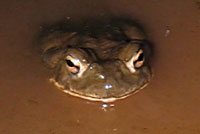 |
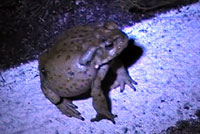 |
|
| Sonoran Desert Toads in a rain pool at night in Arizona, including an interaction between two toads where one makes a release call. Lowland Burrowing Treefrogs and Couch's Spadefoots are calling loudly in the background, which might be why these weak-voiced toads were not calling, only waiting around on the banks and in the water for females to come. |
Several Sonoran Desert Toads out at night in Arizona, hopping and running quickly across desert roads. |
|
|
|
|
| Description |
| |
| Size |
Adults are 4 - 7 1/2 inches from snout to vent (10.1 - 19 cm). (Stebbins, 2003)
The largest toad in California before its presumed extirpation.
|
| Appearance |
A large toad with relatively smooth skin, prominent cranial crests, and long parotoid glands behind the eyes.
There is a large white wart near the corner of the mouth and large warts on the hind legs. |
| Color and Pattern |
Olive, dark brown, or dark gray.
The throat is pale on males and females. |
| Young |
| Young have light warts set in dark spots. |
| Larvae (Tadpoles) |
Tadpoles are gray to golden brown in color.
|
| Life History and Behavior (based on toads studied outside of California) |
| Activity |
Primarily nocturnal. Active on rainy nights, most often from May to July during summer rains.
Often seen on desert roads in Arizona during the summer monsoons where they frequently suffer from road mortality.
During daylight and hot periods, they will take refuge in rodent burrows amd rocky outcrops. How this toads aestivates or survives over long periods of heat and cold is not known, but one radio-tracked toad remained in the same hiding burrow from late September to mid June, where it may have been in a state of torpor.
|
| Movement |
| Capable of moving very quickly with huge leaps, and by running across the ground on all four legs. |
| Defense |
As a defense, Sonoran Desert Toads use their large parotoid glands and other warty glands to excrete poisons that may cause paralysis and even death if ingested by dogs and other small animals. Toads assume a butting pose, aiming the parotoid glands at an adversary. They also inflate to increase their body size.
Skin secretions have hallucinogenic properties.
(This is the toad involved in reports of toad licking or the smoking of dried parotoid gland secretions. Some states have passed laws against toad licking or smoking, and classify the secretions of these toads as a controlled substance.) |
| Longevity |
| Longevity in the wild is estimated to be at least 4-5 years. |
| Voice (Listen) |
A weak, low-pitched whistling screech, 1/2 - 1 second in duration that cannot be heard as far away as many frogs and toads.
The vocal sac is only vestigial or absent.
Calls at night in small groups, after summer rains. |
| Diet and Feeding |
Like most toads, Sonoran Desert Toads eat anything that it can overtake and capture, mainly a variety of invertebrates, but lizards, mice, and toads have also been observed in its stomach contents. Sometimes this toad can be seen sitting at night under a street light, eating passing flying insects.
Tadpoles are presumed to eat algae and detritus. |
| Reproduction |
Reproduction is aquatic.
Fertilization is external, with the male grasping the back of the female and releasing sperm as the female lays her eggs.
Amplexus is axillary - the male grabs the female around her shoulders or armpits.
The reproductive cycle is similar to that of most North American Frogs and Toads. Mature adults come into breeding condition and migrate to ditches and rain pools where the males call to advertise their fitness to competing males and to females. Males and females pair up in amplexus in the water where the female lays her eggs as the male fertilizes them externally. The adults leave the water and the eggs hatch into tadpoles which feed in the water and eventually grow four legs, lose their tails and emerge onto land where they disperse into the surrounding territory.
Breeding locations include seasonal and permanent pools, stock tanks, and irrigation ditches.
Adults breed late spring through early fall, May to September, with the onset of the summer rains.
Breeding often occurs on one night 1 to 3 days after a heavy rain, but if the rain is so heavy that there is substantial flooding, they will wait 2 or 3 days until the water level subsides. 1
Adults travel up to several hundred meters to water.
Males sometimes give an advertisement call, either by themselves or in a small chorus, but they also travel around and search for females, or sit without calling waiting for females to come close enough to grab them.
|
| Eggs |
An average of 7,500 - 8.000 eggs are laid in still or slow-moving water, in long, single, jelly-coated strings or tubes. 1
|
| Tadpoles and Young |
Eggs hatch into tadpoles which are gray to golden brown.
Metamorphosis takes place quickly, usually in less than a month.
Tadpoles grow up to 2.24 inches in length (57 mm).
|
| Hybrids |
Presumed hybrids with Woodhouse's Toad have been found in central Arizona. (Stebbins, 2003)
|
| Habitat |
Outside of California, this toad inhabits a variety of habitats including grasslands, arid desert lowlands, mountain canyons with oaks and sycamores, and pinyon-oak-juniper mountain forests. Found near washes, river bottoms, springs, reservoirs, canals, irrigation ditches, stock ponds, streams, temporary pools, and sometimes away from water sources.
|
| Geographical Range |
The last verified record from California was in 1955, from 7 km north of Winterhaven, but there have been reports of records from near the Arizona side of the Colorado River: near the Cibola National Wildlife Refuge; on the Parker Strip in La Paz County, Arizona; above the confluence of the Gila and Colorado Rivers in yuma County, Arizona; and along the Bill Williams River, Mohave County, Arizona.
(Thomson, Wright, & Shaffer, 2016)
Formerly found in extreme southeast California along the lower Colorado River and in irrigated lowlands of the southern Imperial Valley. It is not known if this toad occurred naturally in the Imperial Valley or if it expanded its range there after the development of agricultural irrigation. (Stebbins, 1951 - Thomson, Wright, & Shaffer, 2016)
Outside of California, the species is found in southern Arizona, extreme southwest New Mexico, and in Sonora and northwest Sinaloa, Mexico, and extreme northern Baja California.
|
 |
| Elevational Range |
From sea level to 5,784 ft. (1,763 m.) (Stebbins, 2003)
|
| Notes on Taxonomy |
The name Colorado River Toad was formerly used for this toad.
Formerly included in the genus Bufo. In 2006, Frost et al replaced the long-standing genus Bufo in North America, restricting Bufo to the eastern hemisphere. Bufo is still used in most existing references.
Changed from Bufo to Ollotis until Frost et al in 2009 showed that Ollotis should be changed to Incilius, Cope 1863.
Darrel R. Frost, Joseph R. Mendelson III, and Jennifer Pramuk Copeia 2009(2): 418
Alternate and Previous Names (Synonyms)
Ollotis alvaria
Bufo alvarius - Sonoran Desert Toad (Colorado River Toad) (Stebbins 1985, 2003, 2012)
Bufo alvarius - Colorado River Toad (Storer 1925, Stebbins 1954, 1966)
Bufo alvarius - Colorado River Toad - Girard's Toad; Colorado Toad (Grinnell and Camp 1917)
Bufo alvarius (Girard 1859)
|
| Conservation Issues (Conservation Status) |
In their survey of 1994, Jennings and Hayes noted that this toad is apparently extirpated from most or all of its sites in California. This is likely due to loss of habitat and to pesticide use brought about by modern agricultural methods. According to a California Department of Fish and Game report, no toads have been collected or observed in California since 1955. This toad has also declined in New Mexico, but is abundant in many parts of Arizona.
|
|
|
Taxonomy |
| Family |
Bufonidae |
True Toads |
Gray, 1825 |
| Genus |
Incilius |
Central American Toads |
Cope, 1863 |
Species
|
alvaria |
Sonoran Desert Toad |
(Girard, 1859) |
|
Original Description |
Bufo alvarius Girard, 1859 - in Baird, Report U.S. Mex. Bound. Surv., Vol. 2, Rept., p. 26, pl. 41, figs. 1-6
from Original Description Citations for the Reptiles and Amphibians of North America © Ellin Beltz
|
|
Meaning of the Scientific Name |
Incilius - Latin - incile = inlet, rivulet, bog + -ius = a suffix used to form adjectives from nouns
alvarius
Latin - alvus = the womb or belly
Latin - arius = belonging to
from Scientific and Common Names of the Reptiles and Amphibians of North America - Explained © Ellin Beltz
|
|
Related or Similar California Frogs |
Anaxyrus boreas halophilus - California Toad
Anaxyrus woodhousii - Rocky Mountain Toad
Anaxyrus cognatus - Great Plains Toad
Anaxyrus punctatus - Red-spotted Toad
|
|
More Information and References |
California Department of Fish and Wildlife
AmphibiaWeb
Hansen, Robert W. and Shedd, Jackson D. California Amphibians and Reptiles. (Princeton Field Guides.) Princeton University Press, 2025.
Stebbins, Robert C., and McGinnis, Samuel M. Field Guide to Amphibians and Reptiles of California: Revised Edition (California Natural History Guides) University of California Press, 2012.
Stebbins, Robert C. California Amphibians and Reptiles. The University of California Press, 1972.
Flaxington, William C. Amphibians and Reptiles of California: Field Observations, Distribution, and Natural History. Fieldnotes Press, Anaheim, California, 2021.
Nicholson, K. E. (ed.). 2025. Scientific and Standard English Names of Amphibians and Reptiles of North America North of Mexico, with Comments Regarding Confidence in Our Understanding. Ninth Edition. Society for the Study of Amphibians and Reptiles. [SSAR] 87pp.
Samuel M. McGinnis and Robert C. Stebbins. Peterson Field Guide to Western Reptiles & Amphibians. 4th Edition. Houghton Mifflin Harcourt Publishing Company, 2018.
Stebbins, Robert C. A Field Guide to Western Reptiles and Amphibians. 3rd Edition. Houghton Mifflin Company, 2003.
Behler, John L., and F. Wayne King. The Audubon Society Field Guide to North American Reptiles and Amphibians. Alfred A. Knopf, 1992.
Robert Powell, Roger Conant, and Joseph T. Collins. Peterson Field Guide to Reptiles and Amphibians of Eastern and Central North America. Fourth Edition. Houghton Mifflin Harcourt, 2016.
Powell, Robert., Joseph T. Collins, and Errol D. Hooper Jr. A Key to Amphibians and Reptiles of the Continental United States and Canada. The University Press of Kansas, 1998.
American Museum of Natural History - Amphibian Species of the World 6.2
Bartlett, R. D. & Patricia P. Bartlett. Guide and Reference to the Amphibians of Western North America (North of Mexico) and Hawaii. University Press of Florida, 2009.
Elliott, Lang, Carl Gerhardt, and Carlos Davidson. Frogs and Toads of North America, a Comprehensive Guide to their Identification, Behavior, and Calls. Houghton Mifflin Harcourt, 2009.
Lannoo, Michael (Editor). Amphibian Declines: The Conservation Status of United States Species. University of California Press, June 2005.
Storer, Tracy I. A Synopsis of the Amphibia of California. University of California Press Berkeley, California 1925.
Wright, Albert Hazen and Anna Wright. Handbook of Frogs and Toads of the United States and Canada. Cornell University Press, 1949.
Degenhardt, William G., Painter, Charles W. , & Price, Andrew H. Amphibians and Reptiles of New Mexico. University
of New Mexico Press, 1996
Davidson, Carlos. Booklet to the CD Frog and Toad Calls of the Pacific Coast - Vanishing Voices. Cornell Laboratory of Ornithology, 1995.
1 Fouquette Jr., Painter, Nanjappa in Lannoo, 2005
Robert C. Thomson, Amber N. Wright, and H. Bradley Shaffer. California Amphibian and Reptile Species of Special Concern. University of California Press, 2016.
Joseph Grinnell and Charles Lewis Camp. A Distributional List of the Amphibians and Reptiles of California. University of California Publications in Zoology Vol. 17, No. 10, pp. 127-208. July 11, 1917. |
|
|
The following conservation status listings for this animal are taken from the July 2025 State of California Special Animals List and the July 2025 Federally Listed Endangered and Threatened Animals of California list (unless indicated otherwise below.) Both lists are produced by multiple agencies every year, and sometimes more than once per year, so the conservation status listing information found below might not be from the most recent lists, but they don't change a great deal from year to year.. To make sure you are seeing the most recent listings, go to this California Department of Fish and Wildlife web page where you can search for and download both lists:
https://www.wildlife.ca.gov/Data/CNDDB/Plants-and-Animals.
A detailed explanation of the meaning of the status listing symbols can be found at the beginning of the two lists. For quick reference, I have included them on my Special Status Information page.
If no status is listed here, the animal is not included on either list. This most likely indicates that there are no serious conservation concerns for the animal. To find out more about an animal's status you can also go to the NatureServe and IUCN websites to check their rankings.
Check the current California Department of Fish and Wildlife sport fishing regulations to find out if this animal can be legally pursued and handled or collected with possession of a current fishing license. You can also look at the summary of the sport fishing regulations as they apply only to reptiles and amphibians that has been made for this website.
Special Animals List Notes, January, 2024:
"Formerly Bufo alvarius. Between 2006-2009, the scientific name has been changed to Cranopsis alvaria, Ollotis alvaria, Incilius alvarius, back to Ollotis alvarius, and then back to Incilius alvarius. The common name has changed from Colorado River toad to Sonoran Desert toad."
|
| Organization |
Status Listing |
Notes |
| NatureServe Global Ranking |
G5 |
Secure |
| NatureServe State Ranking |
SH |
All California sites are historical; the element has not been seen for at least 20 years, but suitable habitat still exists. |
| U.S. Endangered Species Act (ESA) |
None |
|
| California Endangered Species Act (CESA) |
None |
|
| California Department of Fish and Wildlife |
SSC |
Species of Special Concern |
| Bureau of Land Management |
None |
|
| USDA Forest Service |
None |
|
| IUCN |
LC |
Least Concern |
|
|
|






























